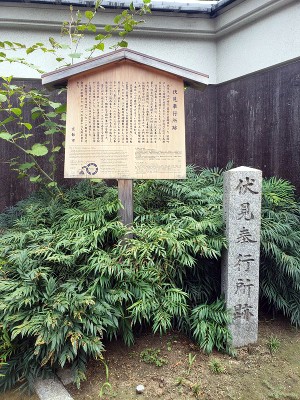Difference between revisions of "Fushimi bugyo"
| Line 6: | Line 6: | ||
The ''bugyôsho'' (Magistrate's Office) itself was a large compound, containing west and east offices, with a main gate on the west side. Stone walls topped with a white plaster wall extended to the north and south of this gate, and ''yagura'' towers were in place to the north and south. | The ''bugyôsho'' (Magistrate's Office) itself was a large compound, containing west and east offices, with a main gate on the west side. Stone walls topped with a white plaster wall extended to the north and south of this gate, and ''yagura'' towers were in place to the north and south. | ||
| − | Naitô Masatsuna served as ''Fushimi bugyô'' in the | + | Naitô Masatsuna served as ''Fushimi bugyô'' in the 1850s. The position was abolished following the death of ''bugyô'' [[Hayashi Tadakata]] on [[1867]]/6/26, with Fushimi being placed into the jurisdiction of the Kyoto ''[[machi bugyo|machi bugyô]]''. The former ''bugyôsho'' then became the chief base for [[Shinsengumi]] and [[Aizu han]] troops, and other forces loyal to the former shogunate in the [[1868]] [[Battle of Toba-Fushimi]], during which the structure was severely damaged by cannon fire from [[Satsuma han]] forces based at [[Gokonomiya Shrine|Gokônomiya Shrine]], and eventually burned down. |
Beginning in [[1871]], the Imperial Guard, and later the 16th engineering battalion were then later based at the site. Today, the site is home to a public housing development. | Beginning in [[1871]], the Imperial Guard, and later the 16th engineering battalion were then later based at the site. Today, the site is home to a public housing development. | ||
Revision as of 01:08, 11 August 2020
- Japanese: 伏見奉行 (Fushimi bugyô)
The Fushimi bugyô, or Fushimi Magistrate, was a Tokugawa shogunate official charged with administering the town of Fushimi. The magistrate not only oversaw administrative and judicial matters pertaining to the town itself, but also river traffic along the Ujigawa, Yodogawa, and Takase canal; tax collection in neighboring villages; and other matters. He was considered one of the shogunate's ongoku bugyô (Magistrates of Distant Provinces), and was sometimes appointed from among the hatamoto, but more frequently from among the daimyô. The most prominent figure to hold this position was Kobori Enshû, known for designing numerous famous and significant gardens in and around Kyoto.
The bugyôsho (Magistrate's Office) itself was a large compound, containing west and east offices, with a main gate on the west side. Stone walls topped with a white plaster wall extended to the north and south of this gate, and yagura towers were in place to the north and south.
Naitô Masatsuna served as Fushimi bugyô in the 1850s. The position was abolished following the death of bugyô Hayashi Tadakata on 1867/6/26, with Fushimi being placed into the jurisdiction of the Kyoto machi bugyô. The former bugyôsho then became the chief base for Shinsengumi and Aizu han troops, and other forces loyal to the former shogunate in the 1868 Battle of Toba-Fushimi, during which the structure was severely damaged by cannon fire from Satsuma han forces based at Gokônomiya Shrine, and eventually burned down.
Beginning in 1871, the Imperial Guard, and later the 16th engineering battalion were then later based at the site. Today, the site is home to a public housing development.
References
- Plaques on-site at former site of the headquarters of the Fushimi bugyô.[1]
